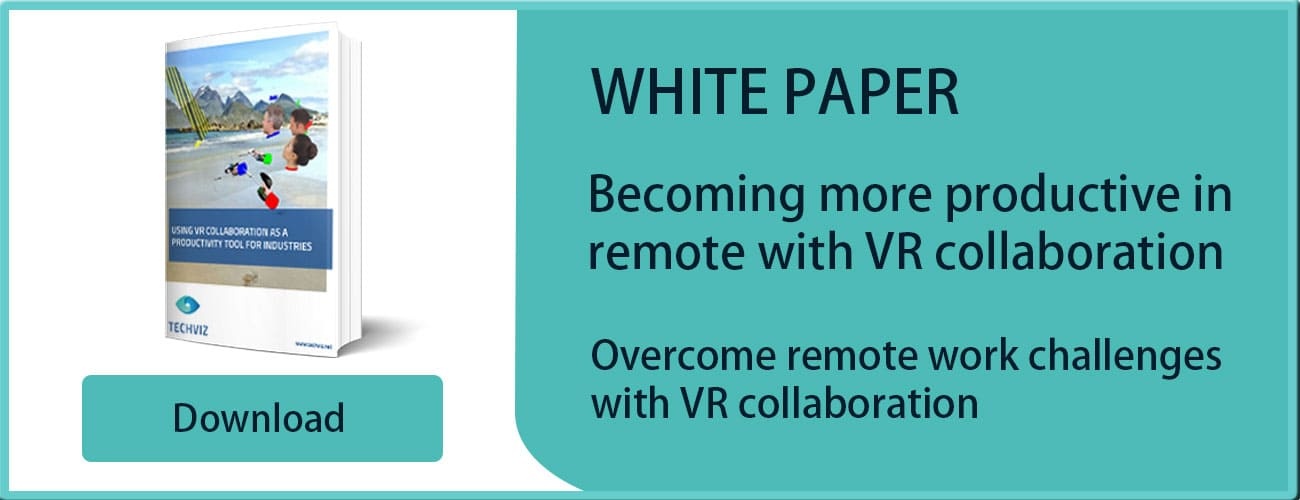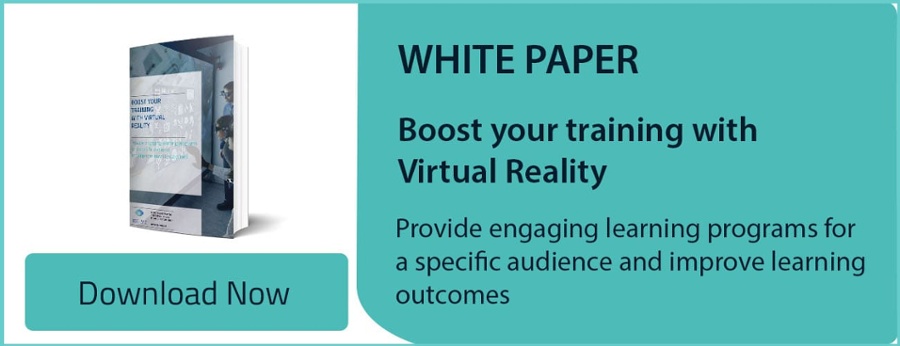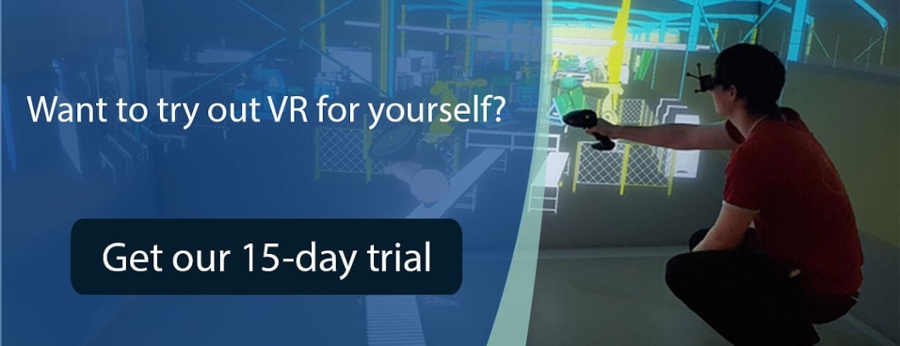Updated September 27, 2022
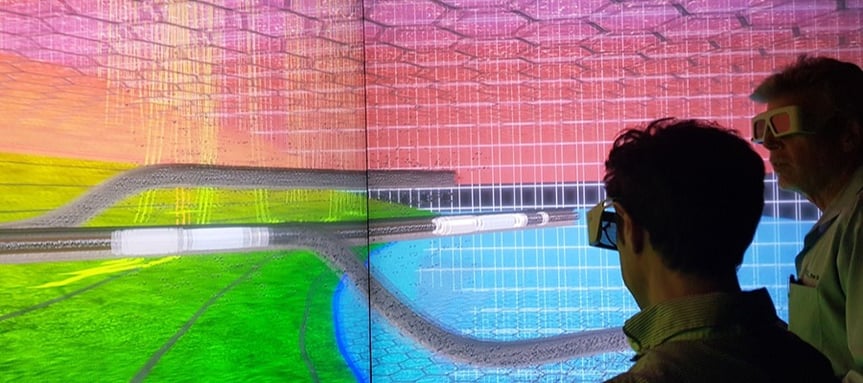
Many businesses have been using virtual reality to improve their processes for years. As a matter of fact, the use of VR in businesses has been accelerated since the covid-19 pandemic, as VR enables to improve business meetings from afar while still having an incredible feeling of reality. More and more sectors accelerating digital transformation are taking advantage of VR for business in order to conceive products with way less errors and collaborate more efficiently with 3D data.
Virtual reality is a computer-generated environment that enables immersion of the users in a virtual world (realistic or not). In a business setting, it means being fully immersed in the data of a 3D application through different display technologies - HMDs, powerwalls or CAVE, and see how to improve a product before having to make expansive physical prototypes.
Throughout this guide, we will talk about the overall use of virtual reality by industrials, and how different sectors can benefit from introducing VR in their processes, such as:
- Aerospace
- Automotive
- Architecture and construction
- Education and training
- Energy
- Manufacturing
- Military and defense
- Pharmaceutical
- Research
- Shipbuilding
Of course, the use of virtual reality in businesses isn't limited to these sectors. So, we will feature other sectors where VR helps your business and some best practices for enterprise virtual reality.
What is VR for business?
Consumer VR vs enterprise VR
Indeed, virtual reality is a reality that has been created by a computer. When you put on a vr headset, you are instantly taken to a simulated environment that completely makes you forget about your real environment.
And even if they more or less use the same technologies, VR for consumers and VR for business don’t have the same purposes.
The most basic hardware to use virtual reality is a VR headset. Some headsets work for both augmented and virtual reality, and some of them are specialized. Not all these HMDs are good for industry use. In reality, you have to distinguish between:
- Smartphone-powered headsets (or Google cardboard)
- Standalone VR headsets (or all-in-one VR)
- PC-powered (or tethered headsets)
VR headsets for pc are more suited for engineering, or other business use. Why? Because they are linked to a powerful computer (with a tether or through cloud technologies), which gives you access to better graphics and computing power. And that’s a necessity when you want to work with engineering software.
For short: if you have a limited use of VR like small video games or limited business use you might want to go for mobile device mounts such as: Samsung Gear VR. But if your need of VR is more specific, go for a tethered device like VIVE Pro, Meta Quest, Pimax 4K, Dell Visor, Varjo VR-3 or HP Reverb.
Also, VR for business isn’t limited to headset uses. Because some use cases might rely on other wearable devices or allow multiple users in the same environment, you might prefer using a projection-based system. A projector shows two sets of slightly different images to create a 3D effect that is only visible with 3D-glasses. If you only have one projector, it is a PowerWall, if you have more, then you have a CAVE (Cave Automatic Virtual Environment) - also called an immersive room. These display systems are most often used for VR collaboration, thus for business meetings in VR.
The difference between virtual, augmented, mixed and extended reality
There are a lot of terms used to speak about immersive technologies, but they don't have the same purpose:
- Virtual reality (VR) has the user in full immersion in a computer-generated environment
- Augmented reality (AR) overlays virtual objects in the real world
- Mixed reality (MR) combines the virtual environment with the real world, and enables users to interact with both realities
Altogether, these immersive technologies form the eXtended Reality (XR).
Virtual reality in the aerospace industry
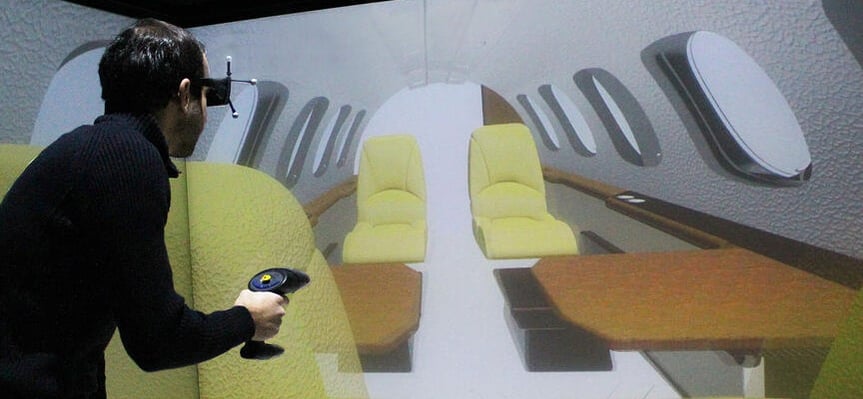
The aerospace industry covers both aeronautics and spaceflight. It includes research, development and manufacture of flight vehicles, missiles, space launch vehicles and spacecrafts. Their product line is very broad, as an airplane can require up to one million individual parts. Besides, there is also a need for many software and technology to support designing, operating and maintaining the vehicles.
Aerospace products and processes are very complex, and require a lot of skilled personnel. From product development to training specialized staff, fully immersive virtual technology fits very nicely in this ecosystem. The aerospace industry is very dependent on new technology. This market happens to be very competitive and of course there is a constant need of improvement of products regarding performances but also safety, so every actor thrives to create new models more advanced than its predecessor. The complexity of the product and the competition often require the use of better designing methods to cut down time and conception costs. Virtual reality is the best tool for this task, as it enables engineers and designers to collaborate on large-scale and complex models in 1:1 scale.
As VR makes conceiving new models easier, the addition of new technologies in the industry impacts all aspects of the crafts. The new aircrafts being at the cutting edge of innovation, employees will need training to operate and maintain them. Virtual reality training helps both pilots and specialized technicians.
With TechViz VR software, you can use your own CAD models in virtual reality without data conversion, When you work in an industry who subcontracts the conception of the different product parts to different suppliers, being able to collaborate in real time in the same virtual environment with 3D models from different applications is a real asset to review the complete virtual prototype.
Virtual reality in the automotive industry
The automotive industry is a fast-paced sector that always adopts new technologies like virtual reality for their digital transformation. VR collaboration happens to be a very fit feature for this sector, as many departments are involved in the conception of a new vehicle. Before using VR, 2 to 3 years were needed, and sometimes even longer, to launch a new car. With virtual reality, a car manufacturer can create a new model in a matter of months.
However, VR isn’t just an asset for the engineering process. It helps for every stage of product development: design, ergonomy, safety to market. VR collaboration on the same CAD model helps design teams and engineering teams reach for a compromise more easily. Also, VR enables the users to interact with the model intuitively, so getting helpful input from departments who get the end-consumer’s input like marketing, sales and support.
Being immersed in their own 3D model makes interior design easier, as the viewer can see if every command is accessible. Added with wearable technologies like full-body tracking, engineers can make accurate ergonomic studies in VR. Also, you can imitate an operateur in his work environment with a virtual manikin for further ergonomic testings.
Virtual reality in the architecture and construction industry
Virtual Reality is being more and more used in architecture and construction. For those industries relying on design, one of the biggest challenges is to convey 2D information into an accurate construction project. But however talented the designer may be, translating the drawings from a plan - if the plan is a drawing - into a 3D representation can lead to many errors. And we’re just talking about new constructions; things get even more complicated when it involves already-existing buildings.
Virtual reality changed tables, as there is no room left for mis-interpretation. From the initial drawings, to the collaboration with the different stakeholders, VR keeps everyone on the same page. Whether it’s for helping the architects sell the idea to a client or conveying the directions to the construction workers, interactive virtual reality is helping a lot. And if you can combine virtual reality with BIM data and 3D point clouds, then you win on every table.
Convincing a client that a design is feasible is hard. Even when the design is rendered in 3D on a computer, having to imagine how plans will render in real life is no easy task. Now multiply that number of interpretations by the number of people collaborating on the project. How do you expect to receive any valuable feedback? With multiple decision-makers involved in the project comes the need to actually get all these feedbacks. Gathering all these people at the same time is incredibly complex, and not to mention ineffective and time consuming. Nothing could be easier with a VR collaboration software that enables you to share the same virtual environment with an unlimited number of collaborators, and take measures, photos and notes to make the design as accurate as possible.
VR models can go even further in order to simulate the building in a real-like environment. You need to know what it feels like to see through a third-floor window? Or navigate from room to room, switching lights on and off and opening doors? Analyzing how clients interacted with the VR content provides interesting feedbacks for AEC companies. It shows how they could engage with the 3D data, what they could enjoy and what they could struggle with.
There are many benefits of using both BIM and vr in construction. It enables every collaborator to give their input earlier in the construction process, so that all the errors can be detected in VR before the construction really starts. It also helps optimizing costs and schedules, because you can compare both the as-constructed and the as-planned data in the virtual world, and see if you’re up to date or not and if the requirements have been fulfilled. This leads to an increase in the speed and quality of the overall project, while keeping an eye on spending. And as the mistakes are prevented earlier-on in the process, it makes you reduce costly rework.
Virtual reality for education and training
Education and training content get more accessible through the internet. However, accessing the information and really getting a new skill require effective teaching methods. Especially when knowledge continues to evolve, outdating what we’ve learned before. Virtual reality transforms the way we teach, train and learn, and the way the educational content is brought to learners.
In reality, VR training won’t replace all training sessions. However, it is most adapted in some situations and use cases. For instance, when the use case is too rare, too dangerous or too expensive to happen in real life. Here are some other reasons why VR training is a great way to teach other people:
- VR tools adapt to the way and rhythm of the learner
- VR scenario can be repeated (with slight variations) to ensure retention
- Randomized VR situations keeps users alert and engaged with the course
- VR environment are risk-free and enable to learn by making mistakes
- VR content can be re-used for different audiences
- VR enables students to collaborate efficiently, even remotely
- VR training can be adapted to all kinds of learning purposes
Please note that sometimes, a simple headset won’t suffice when it comes to learn highly specialized skills, and the use of a powerwall or a cave vr will be required. TechViz software can be used for training specific audiences in virtual reality, such as skilled maintenance workers.
Virtual reality in the energy industry
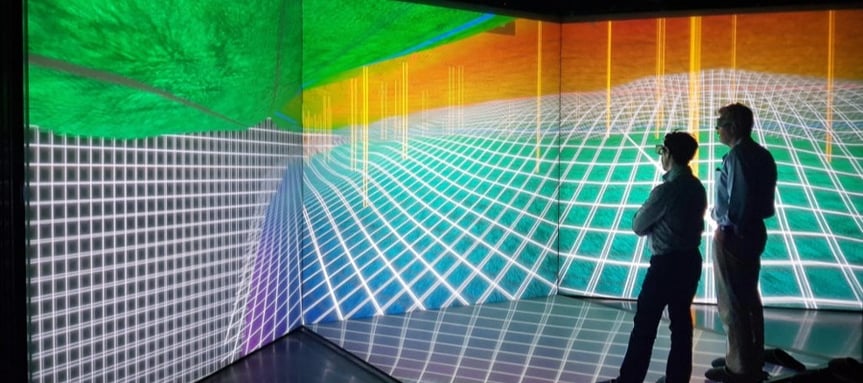
The energy industry includes all the industries involved in the production and sale of energy, such as fuel extraction, manufacturing, refining and distribution. The energy sector is a very important infrastructure and maintenance of modern society. Virtual reality for the energy industry can provide lots of benefits from conception of heavy machineries, to rigorous monitoring or operations and maintenance, or effective VR training for specialized workers.
Virtual reality training is one of the most common use cases in the energy sector. Why? Because it involves many precise and complicated process, and transmitting those crucial skills is essential. The expectations and requirements for running the operations, and maintaining the machinery are quite high, and there are many risks involved too. VR enables high quality and risk-free training for all employees, and don’t rely on site training. This is a real asset when you have to send recent graduates on the field: they already know everything they need to run the operations and maintenance smoothly.
Imagine if you have to train your workers for a failure in a nuclear plant. Maybe it’s better if you can train them in a real-like VR simulation instead of replicating real-like emergencies on site. Besides, virtual reality training enables your workers to train from a remote location, so you also save the resources needed to transport the trainees and book the site for the training session. VR training is very helpful when you need a specific training environment, such as your own manufacturing site, or deep-water environments.
Outside safety training, virtual reality also brings the idea of remote repairs in the energy and utilities sector. Imagine that with the right VR solution, you can easily diagnose the problem before sending a technician on-site. With a 3D rendering of the actual equipment, the workers can easily identify the best route to reach the problem, and order all the necessary parts and tools he needs for the real repair.
Virtual reality in manufacturing
Industry 4.0. is the end of manufacturing as we know it. Huge amounts of data are generated everyday through our manufacturing line, and by the ecosystem around it. Virtual and augmented reality (AR/VR) is just one of the most effective ways to visualize and exploit this data in manufacturing. For now, most of the manufacturing industries who are currently using VR are “Digital Champions”.
The factory of the future has become more versatile and adaptable, for it should be able to follow market trends. Virtual reality is one of the many tools industrials can use to shorten and optimize product development. The overall goals of introducing VR in the manufacturing process is to cut operation and maintenance costs, achieve better machine ability and reduce downtime. VR also helps with training the operators and technicians when a change in a market affects the manufacturing line.
Here is some use cases where you can use a VR software - like TechViz - in a manufacturing industry:
- Conception and engineering: visualizing the CAD/CAM model of your product, or your production line, in 1:1 scale is more cost-effective.
- Floor planning: it is so much easier to use VR to anticipate the space and dependencies between the different production units, and optimize production time.
- Maintenance and inspection: today’s machinery is getting too complex to be inspected and maintained by your regular factory staff. However, what can you do if an equipment suddenly malfunctions? With VR you can do more regular and remote check-ups of your machines, which not only helps cutting costs but also prevents most of factory downtimes.
- Safety training: training for hazardous tasks is easier in VR than in real life, as you have to reproduce steep requirements while exposing your teams to danger. Plus, you can provide many different training situation in VR and repeat them until your teams are confident of their proficiency.
Virtual reality in the military and defense industry
There are four main uses of VR for military purposes:
- Training specialized personnel
- Running simulations
- Engineering new products and maintaining previous ones
- Remotely collaborating on military missions
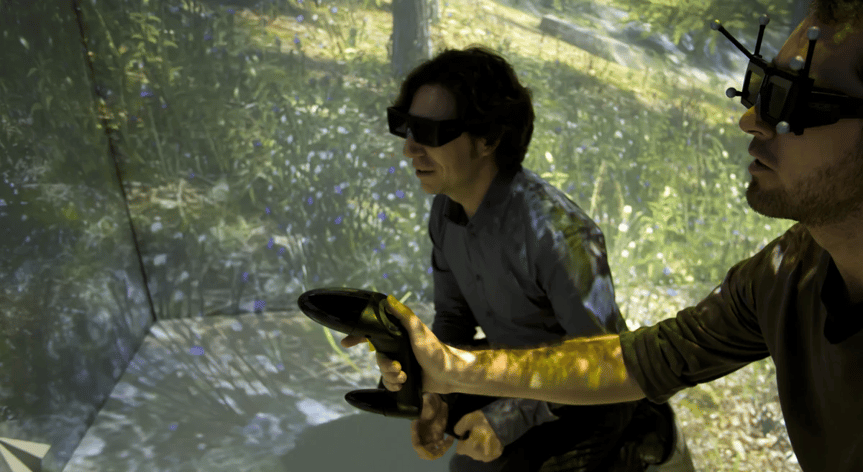
Effective training is essential to the preparedness required in the military. The quality, consistency and frequency of the training, as well as the accuracy of the provided data, is a cornerstone in Virtual reality training in the defense industry. The use of VR environment aims at bridging the gap of other training formats, as the actual response of the personnel in the field greatly depends on the skills they acquired during training. Virtual reality enables to include real-like worlds to the training sessions, and may be augmented with other devices like body or head tracking and other sensory inputs that will help with immersion and data collection. This method promotes experiential learning.
Using VR simulations is not only useful for training. For example, a combat simulation can take place in a 3D environment where the recruits (wearing an HMD) can interact and navigate in real-time. Not only can it teach new skills, but also prepare the teams for a real operation. Virtual reality simulations can also show how vehicles or weapons behave in different types of environment and weather conditions.
This latest information will be very useful to maintain previously acquired equipment, and engineer better ones. For instance, if your vehicles are operating in the desert and you notice some parts are getting wear marks more frequently, then you know what parts to order to repair said equipment. And you also know from field experience what parts need to be optimized for a use case or another.
The employ of remote technologies or telepresence in the military helps reducing the exposure of agents to hazards and increase their stealth on military missions. For example, reconnaissance missions take time, a period during which they are exposed to hostile fire. Some of the reconnaissance equipment can be remotely-controlled by an agent in a virtual reality created from the reconnaissance data. The advantage of operating from a remote virtual environment is not only safer for humans, but can also be done by a smaller vehicle, as it doesn’t need to transport people.
Virtual reality in the pharmaceutical industry
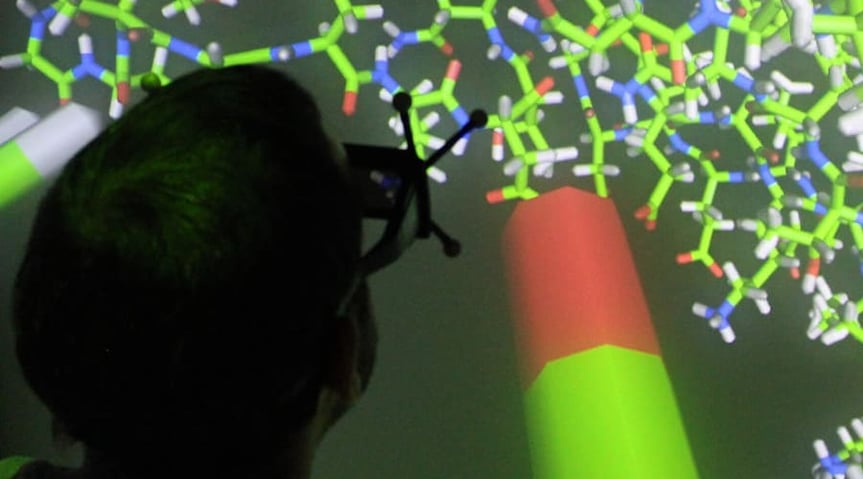
Unlike other sectors who took to virtual reality lika a duck to water, the pharmaceutical industry is slowly adopting the new technology. But even if it is still at the early stages of integrating augmented and virtual technologies, pharma companies will have many applications for VR.
Nowadays, drug research is very dependent on 3D modelling, as it enables to fully visualize new molecules. With VR, they can immerse themselves in their data, and get more accurate representations of which molecule affects the disease target, and run real-time simulations for prediction studies. VR simulations also help in the process of reverse-engineering a biological system, like bacteria or viruses, or delve into areas we don’t fully understand. Once the simulation is created, it can serve as a hypothesis generator. It accelerates the pre-develop phases for creating new drugs, with the visualization the interactions between molecules better. Plus, it can help predict the interaction between different chemicals, and predict the interaction between the drug and their target. Finally, by scanning different potential drugs, VR simulations provide a theoretical framework with a real-like environment that can be used for developing new drugs, studying their impacts, and help for drug repurposing.
When it comes to the manufacturing phase of drugs, VR will help at different levels. As it requires very specialized equipment to create the final products, virtual reality trains specialized workers to operate the machines. It will ensure that there are no mistakes done during the real production. Plus, the more the technicians will train in VR, the more the operations will improve, so VR training as a high return on investment.
Virtual reality in research
There are many applications of virtual reality tools in universities, either as a research tool or as a way to teach students. VR can also be used to give a new place for the universities in the research and development ecosystem. In fact, research doesn’t always lead to a commercially viable product, and exchanges between young companies and universities can be very prolific. Many non-traditional players are entering research and development in many fields (such as automotive, aerospace or defense). However, these companies don’t have the resources to access engineering tools like a CAVE system. Some universities like Wichita State University in Kansas, Ghent University in Belgium or Ostfalia University in Germany give access to their immersive room in order to accelerate local VR innovation.
Virtual reality helps searchers and engineers to test different strategies and configuration, or what-if scenario. Because it can integrate many different data, and help making sense of it by visualizing them in a realistic environment, VR simulations help refute unsound hypothesis and guide the design of novel experiments. It helps creating controlled and repeatable situations in order to test the different variables, even for situations that could be otherwise impossible, too dangerous or too expensive in the real world.
Several universities also rely on VR for knowledge transfer. Skill transmission is easier with virtual reality settings, because it adapts to the teachings and student’s learning behavior. With VR, some of the barriers of learning are lifted: learners can get a better understanding of abstracts concepts, despite the language barrier. Not to mention that the mastery of VR tools will be essential for the future of work. Teaching today’s students about Industry 4.0. and the new engineering tools is crucial to prepare the global digital transformation.
Another interest of virtual reality for science applications, is that it drags attention, and makes things “easy” to understand, or at least more visual. It can be hard to explain why your research project should get findings, especially when working on abstract subject. VR can help you convince investors to fund a research project, and also give you an effective communication tool to make your research known and more accessible to a broader audience.
Virtual reality in the shipbuilding industry
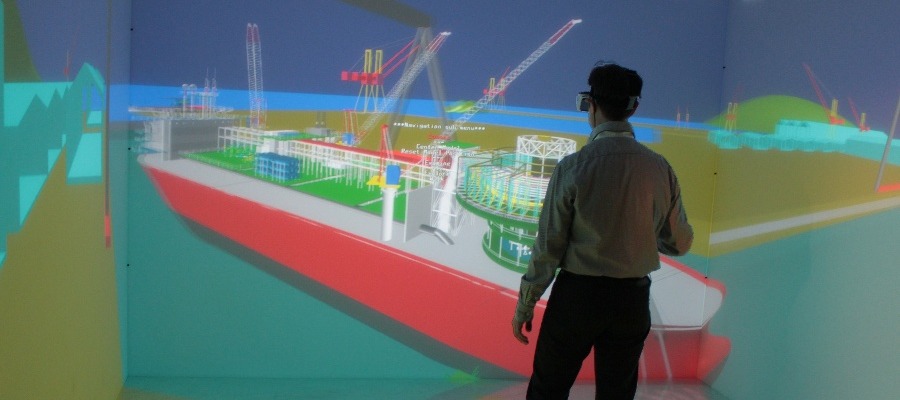
Virtual reality is changing the game for the shipbuilding industry. Just like other sectors dealing with large models like aircrafts or machinery, designing a ship is a long and costly endeavor. Many producers have already included VR in their product development process, in order to conceive fewer and better products, and deal with bespoke adaptations.
The first thing VR brings to product development, is the optimization of design reviews. Before using virtual reality, testing and enhancing prototypes was a very long process, requiring multiple iterations of physical models of the different parts. The introduction of virtual reality design tools helped companies to get a full prototype at the early stages of product development, which helped detecting potential risks and mistakes and get the input of other departments that are directly in contact with the buyers.
Most of large ships or submarine include custom-made adaptations. Despite all these changes from one model to the other, all the usual safety and ergonomics standards must remain the same. Virtual reality helps for checking and validating operations and maintenance tasks. Within the virtual environment, engineers can check how the task is done, and if it fits with the requirements, using collision detections as well as full-body tracking equipment. This way, they can check if the task can be done, and if it isn’t too strenuous on the technician.
Finally, as shipbuilding involves many R&D centers and other stakeholders, smooth collaboration between teams working on the project is essential. In order to deal with the globalization of the shipbuilding sector, and the new restriction, collaborating remotely in real-time in the same virtual environment poses often a challenge. Virtual reality is the best tool to overcome this difficulty. Working in a shared virtual room enables everyone to give meaningful input on the project, from wherever they are, no matter how great the distance is.
Other businesses that can benefit from virtual reality
Virtual reality in the healthcare industry
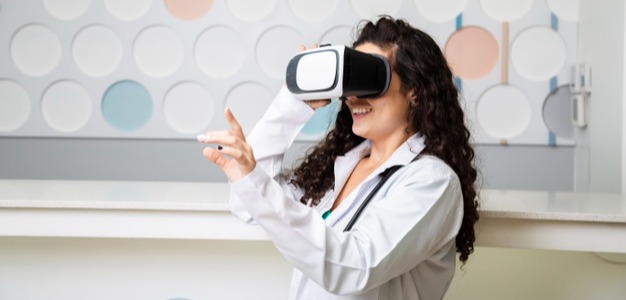
From developing new medical techniques to train future doctor and nurses, virtual reality has many applications in the healthcare sector. Virtual reality and mixed reality have primarily used for knowledge platforms, guidance systems and simulation practice. Either the VR training focuses on a specialized skill or a field or knowledge, runs an immersive medical scenario, or trains the user for telemedicine. Here are some applications for VR training in the healthcare sector:
- Provide interactive 3D models of anatomy
- Acquire new cognitive-psychomotor skills (for instance in surgery)
- Complement real practice in a safe simulation environment (contributes to patient safety)
The role played by virtual reality in health care is getting larger every day, especially because it gives new ways to reduce pain or provide therapy. However, many uses of virtual reality in the healthcare sector are still at the research stage, and have not made their way to the general public yet. Besides, many applications not only require a virtual reality system, but also other sensors and input modalities, such as eye-tracking, motion tracking or brain-computer interfaces. Commercially viable VR systems in healthcare are not commonly used for now. This highlights a potential evolution of the market, for instance in remote health settings.
Virtual reality in advertising
Virtual reality helps advertisers reach their audience more efficiently, with immersive VR content. Unlike conventional ads, VR ads are more engaging for the viewers, because they are fully interactive. This kind of content not only helps promoting sales, but also increase brand awareness. VR as a sales rep tool was used, for example, in healthcare advertising. It enabled brands like Acadia Pharma to put the viewers into the shoes of different persons suffering from Parkinson’s disease, or Greenwich Biosciences who walked a medical conference attendee through the 3D rendering or their manufacturing line.
For real, VR in advertising is still limited to a small audience. Either it’s people who customary use it, like gamers, or it requires a special event where people can be provided with headsets. There is still a long way before it reaches the general public. However, for specific audiences, the results are encouraging.
Virtual reality in e-commerce
As always, there is a struggle between shopping online and shopping in a physical outlet. Most of people prefer to purchase products from physical stores, because they can experience the product in reality. With Virtual reality you can combine all the benefits from both the online and physical store. Who wouldn’t want a fully immersive experience to test the real product in the comfort of their own home? A simple HMD and you can stroll across a product store instead of scrolling on a product page. Or instead of a full virtual showroom, you can just include VR content for your products. If the shoe fits…
Virtual reality for events
Since the Covid 19 period, many events or shows have gone digital. Because VR still needs to seduce a broader audience, let alone the general public, it is still limited to small events or specialized ones like VR-Days. But with VR hardware getting affordable, no doubt this application can look forward to a bright (virtual) future.
Virtual reality in the gaming industry
Everyone links virtual reality to the gaming industry. The overall awareness of virtual reality, and the entertainment sector business value, has been pushed by the progress of virtual and augmented technologies. Virtual reality games are of the hottest topics right now, and its possibilities have benefitted other industries as well. The VR hype fuels the entire market, from VR content creators to hardware producers, and pulls the market towards more innovation and diversified use cases.
Virtual reality for marketing uses
Virtual reality plays an important role for user experience, as it immerges the user in a three-dimensional virtual world. The virtual reality systems usually give visual and auditory feedbacks, and can be supplemented by other devices for other sensory feedbacks (mostly touch or smell), in order to further the immersion. The immersion of the user in a virtual world created by a company makes it powerful marketing tool.
A key area for virtual reality in marketing is brand management. For instance, many car brands like Nissan, Volvo or Honda have created VR applications too either explore a vehicle, or design their own. As the user is enjoying the virtual experience, they further their relationship with the brand.
Virtual reality can also be a tool to study the consumer’s decision-making process, which can be very useful for market research. For instance, the same VR content you can use for virtual prototyping and design review can be used more broadly to get customer feedback on store layout or product packaging.
Virtual reality for the real estate industry
Buying or selling a property is typically inconvenient and time-consuming. Mostly because you need to set a meeting with the clients for the different visits, there’s all the traveling expenditures to count as well. Besides, a lot of clients first search on the internet for the best properties. With VR, your clients experience a virtual reality showcase and do all the visits simply equipped with an HMD. With VR, they can narrow their choices down, and the presence of the real estate agent might not be necessary in the guided visit.
Virtual reality for the retail industry
As stated for e-commerce, virtual reality can offer a more entertaining and engaging retail experience. This technology will be particularly useful for complex or customized products that can’t be seen easily through a computer screen. VR allows for a better product trial before purchase. This works for stores, for example for trying on clothes, but also for other virtual reality experiences like test-driving a car.
Virtual reality in the tourism and travel industry
Businesses operating within the travel an tourism industry have quickly adopted virtual reality When a client wants to prepare for a trip they need a lot of information. VR enables virtual visitors to plan for their future accommodations, by conveying all the needed information in an immersive way. These experiences can be done from home, but also during your trip to your destination. Did you know that some providers use VR to advertise (and hopefully up-sell) a visit to other tourism attractions? It has a better ROI than just giving a brochure.
Depending on your use case, you might need to rely on different software and hardware. Consult with VR/AR experts like TechViz team to identify with you the right equipment for your specific use cases.
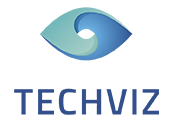





 Back to Blog
Back to Blog
